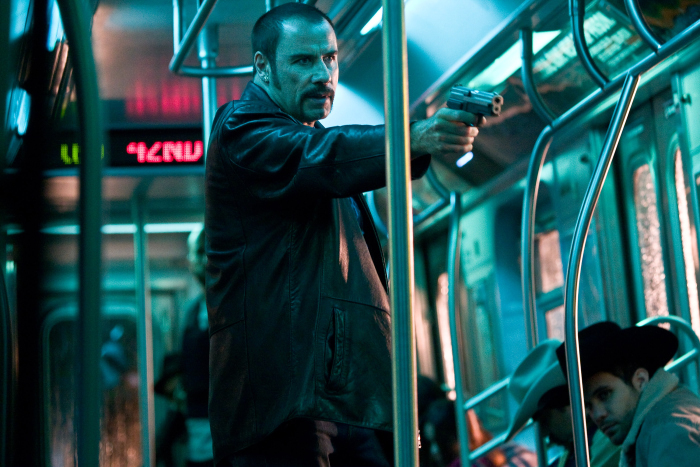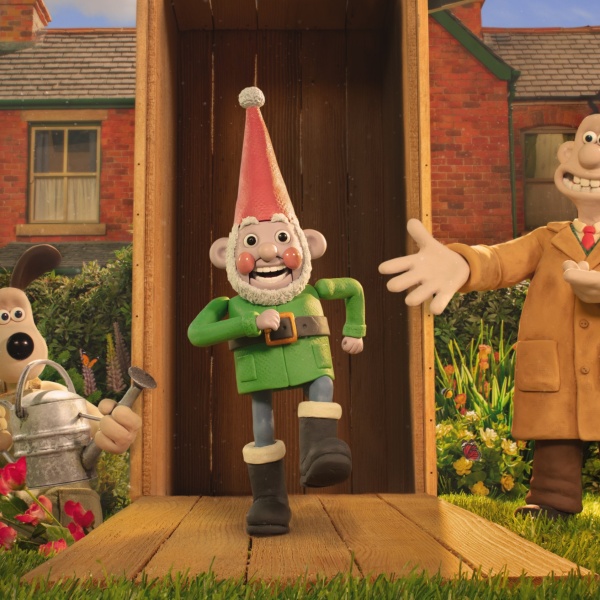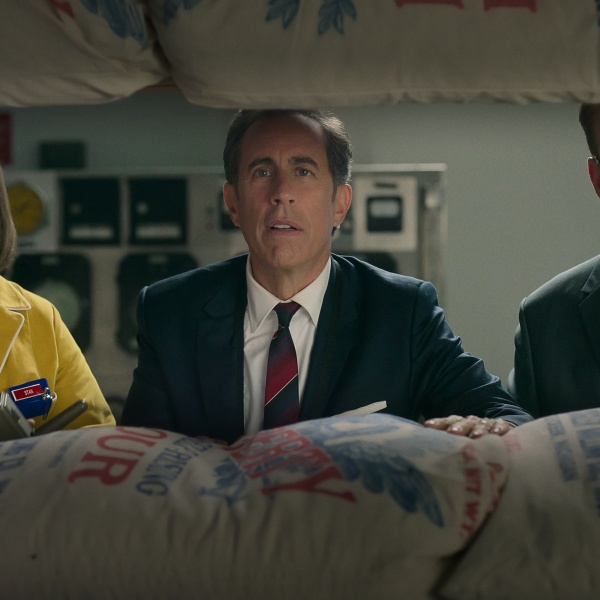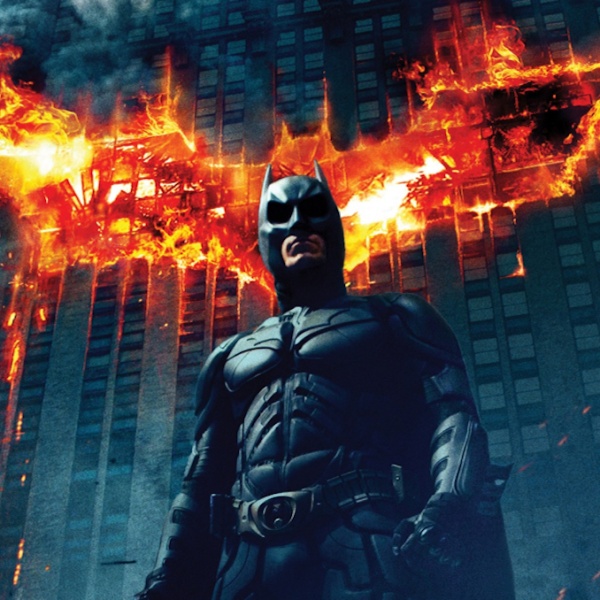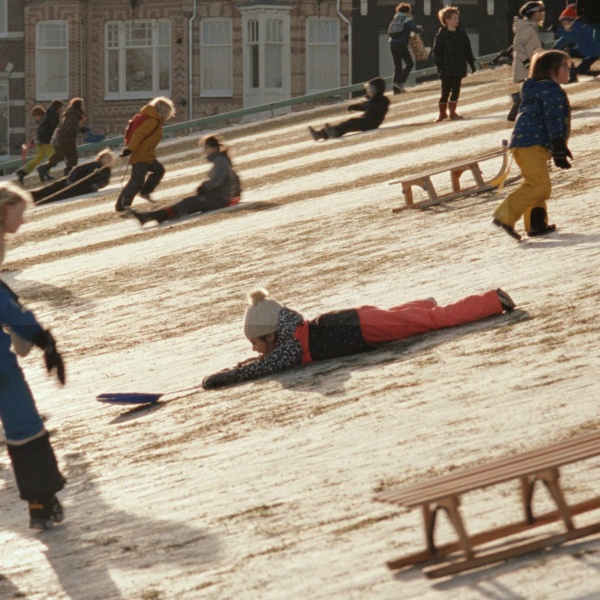Films and trains: they go way back. Take the Lumière brothers‘ pioneering their new cinématographe invention in 1895 with “Arrival of a Train at La Ciotat” or 1903’s “The Great Train Robbery,” widely considered to be the foundation for all narrative cinema; it seems that back then, anyone holding a movie camera could think of nothing better to do with it than point it at a train. The two were, of course, born of similar mechanical, pre-electronic technology; cogs and spokes and sprockets keep a locomotive on its tracks, even as their tinier counterparts spool celluloid through a projector.
It’s a love affair that continued throughout the 20th century, despite the eventual decline in rail use as the car became dominant (spawning its own film genre, the road movie, which we list-ified last week), so much so that unless you’re the type to hang out by the station in an anorak with a notepad and a thermos, it’s probable that the aura of romance that still clings to train travel is in fact due more to its cinematic heritage than to any actual experience you’ve had. The truth of modern railways may be humdrum and prosaic, but with the application of only a very little imagination, they can evoke, if not the Hitchcock era of hearts breaking, ladies vanishing and men on the run evading pursuers by kissing blonde strangers in the dining car (NB: do not try in real life), then at least the kind of lean, action-oriented fun on display in this week’s new release “Unstoppable”.
You know the drill: using said Tony Scott movie (check out our retrospective here) as an excuse, we’ve compiled a list — some of the following films are good, some not so good, but they all in their way contribute to the cinematic mythos of the train. So close the compartment door, lean your head against the window and let the rhythmic rattle of The Playlist’s Notable Train Movies lull you into a semi-altered state, while the scenery rushes past outside.
 “Brief Encounter” (1945)
“Brief Encounter” (1945)
Of all the films on this list, David Lean’s “Brief Encounter” may be the one to spend the least time actually on a train, instead confining itself for the most part, to the station in the little suburban town of Milford (don’t look for it, it’s fictional). But anyone who believes that a little railway station can’t be as effective a setting for a doomed romance as the midst of war or a sinking boat clearly hasn’t seen this. Adapted by Noel Coward from his play “Still Life,” what stands out today — despite the cliché of clipped repression that’s come to characterize the film — is that it’s a work of very deep feeling and passion. Celia Johnson and Trevor Howard as the central pair both give indelibly great performances, the former picking up an Oscar nomination for her troubles. The simmering love between them is one of the screen’s great romances: when their final goodbye is interrupted by a gossipy acquaintance, your heart breaks along with Alec and Laura’s. For a writer so often insufferably arch, Coward’s script is witty but entirely human, and Lean, in the last and greatest of several collaborations with the writer, shows the promise of the genius-level director he would become, never once letting the film seem stage-bound. And, as a freezing February open-air screening on the roof of the National Theatre in London proved to us a few years back, it’s the best Valentine’s Day date option you could hope to find. [A+]
“Danger Lights” (1930)
A seriously creaky hour-long film (partially due to the very dirty print we saw), this one is really for steam train enthusiasts only, as it features very rare footage of a working ’30s railyard and not a whole lot else to pique modern interest. The plot is a rather typical melodrama from this era or earlier — Jean Arthur finds herself torn between her kind railyard-owner fiancé and the hobo he helps, who she falls for in a big way. Everyone struggles to do the decent thing and everything works out for the best. Overall, this curio is a summary example of how the coming of the sound era heralded a brief period of artistic regression for the medium, as the stunning visual heights reached by the end of the silent period were compromised in the service of giving the people the sync sound they craved. [C]
 “Boxcar Bertha” (1972)
“Boxcar Bertha” (1972)
One year before directing “Mean Streets,” Martin Scorsese made this modest Depression-era Southern crime caper. Reportedly made for a mere $600,000 and produced by Roger Corman (jeez, is there a major 1970s American film director who didn’t get his start from him?), the film stars an ethereal Barbara Hershey as the titular character, and David Carradine (“Big” Bill Shelly) as a labor organizer-turned-criminal. The two lovers, along with a gambler and friend, find themselves on the run from the law and hijack a train, embarking on a crime spree across this fair land of ours. Eventually, “Big” Bill falls into the hands of the law, forcing Boxcar Bertha into a life of prostitution. The two eventually reunite and things do not go swimmingly. The film throws in some moments of levity (particularly funny is an anthropologist beginning his visit to Bertha’s prostitute with “anthropological” questions) as it veers between serious social commentary (race relations) and the familiar trappings of exploitation films (nudity and violent gun play). While the film doesn’t quite change the course of film history, it does have its moments and is generally well-directed with many of the usual Scorsese flourishes making their appearance: quick cuts, savvy marriage of music to film (this time twangy and honky-tonk Depression-era music accompany the images), and fluid camera movements. An enjoyable film that is definitely not only for Scorsese completists. [B]
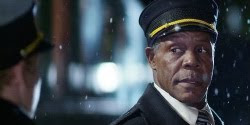 “Night Train” (2009)
“Night Train” (2009)
With a solid B-cast of Danny Glover, Leelee Sobieski, Steve Zahn and Richard O’Brien (mostly in drag), and a ropey, but not without possibilities B-plot (a man dies on a night train leaving a mysterious box that, like the One Ring, instills in everyone who looks into it a homicidal desire to own it at all costs), who’d have thought that the thing that totally, um, derails this whole enterprise would be…the lighting? But honestly, while it was clearly made on a shoestring budget and the sets are dodgy as fuck (especially the terrible exterior shots), these are forgivable crimes; the eye-jangling lack of depth or shadowing that highlights the production’s shoddiness, however, is not. It’s the poor photography more than any other element that makes this thing look not even made-for-TV, but more like an amateur video of some community theater project on a local access channel. Yup, it’s pretty damn awful, but not for the reasons you might initially think. [D]
 “Strangers on a Train” (1951)
“Strangers on a Train” (1951)
If anyone could make a simple exchange between two people unnerving without a detectable reason, it would be Alfred Hitchcock. Opening on two characters in a train car, one a fairly eminent tennis player (Guy, Farley Granger) and the other a troubled man well-versed in celebrity tabloid (Bruno, Robert Walker), the director orchestrates a subtle undercurrent of tension and discomfort before any semblance of “murder” is even muttered. Bruno expounds on his theory of how two strangers can commit a murder for each other and get away with it undetected, eventually suggesting that he can take care of Guy’s troublesome wife and Guy, in turn, could off Bruno’s pain-in-the-ass father. Guy humors him and departs the train, but soon after his wife ends up dead at a carnival and he finds himself locked into the plot he initially laughed at. “Strangers on a Train,” of course, has plenty incredibly well-crafted and intelligent scenes, and while it’s not the most consistently paced Hitchcock, it’s still a very solid thriller. That said, it’s also a great celebration to an almost long-gone type of train travel, which makes up nearly all of the various journeys in the film. Old Alfred doesn’t just see the locomotives as another enclosed playground to throw his actors in — there’s another eye here, one keen on capturing the environment and the various relationships concocted by completely different individuals. Everyone has a story, and the filmmaker’s interest in the relationships in these comfortable (and borderline extravagant) mobile living rooms, is not only most apparent in the central one that holds the story, but in the scenes that exist outside of the narrative, most notably a certain one involving Guy. On his way home, Guy sits with an elderly professor who is appropriately sloshed, informing him of his recent lecture, in between interludes of song. The scene is not only playful, but genuine in its authentic look at human interaction. Although the drunkard, now soberly dignified, is squeezed into the plot as a witness to Guy’s whereabouts during the murder, the professor can’t remember him and this alibi is quickly dismissed. The scene itself could’ve easily been trimmed or cut all together, but the insistence of its inclusion begs for dissertation, or at least attention. It’s Hitchcock really observing a truthful moment outside of the restraints of the thriller genre he worked in, and these authentic scenes are very rare for a thriller in the time it was made. Paying tribute to an era when trains weren’t just 70 people crammed into one cart or people with their iPods and Kindles in bland booth seats, he showed that they were welcoming and leisurely, ripe for social interactions of all kinds. [B+]
 “Café Lumière” (2003)
“Café Lumière” (2003)
Sandwiched between the charming “Millennium Mambo” and the ambitious triple-threat of love stories chronicled in “Three Times,” the studio-funded ode to Ozu and composer Jiang Wen-Ye also functioned as a love letter the locomotive. Yoko (Yo Hitoto) finds romantic interest in Hajime (Tadanobu Asano, of “Ichi the Killer”) while researching the life of the deceased songwriter. As a man that’s obsessed with trains and devotes much of his time to sound recording various different lines (even constructing a deftly detailed art piece involving trains and himself, fetus-like, in the middle), he’s fairly emotionally distant and Yoko’s interest goes deftly unnoticed. Throwing his own style and Ozu’s in a blender proves to be unmoving, as Ozu’s tone is drained of charm and in turn the picture feels haphazard. The focus on trains is equally aimless; it never feels particularly special or affecting no matter how much director Hou Hsiao-hsien drives it home, despite the lengthy duration of attention it is given. The scene in which Hajime shares his train picture with Yoko is the biggest offender, and instead of being intimate the insistence of the director is blatant. Consequently, the tone becomes rather silly and the rest of the film a chore. [D+]
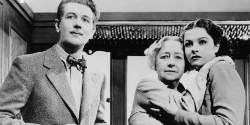 “The Lady Vanishes” (1938)
“The Lady Vanishes” (1938)
Alfred Hitchcock’s early British mysteries are marked by wit, humor and a positively romping pace, and “The Lady Vanishes” is no exception — in fact, it’s one of his most exceptional early films and one of the last he made in England before packing it up for Hollywood. The picture is a classic psychological mystery, and another Hitch-confines-himself-to-a-single-setting exercise in suspense. It’s also totally absurd and hilarious; an outright comedy from the master of suspense, concerning a group of British travelers in the fictional country Bandrika (but why do the locals have Italian accents?), who are tossed together in a local inn when their train is delayed by an avalanche. Young Iris (Margaret Lockwood) gets brained by the ol’ falling flower pot maneuver while waiting on the platform, pushed by a pair of hands intending the pot for governess Miss Froy. Iris dozes off on board the train and awakens to find seatmate Miss Froy gone, and no one willing to even admit they saw her, or believe Iris herself. She and fellow traveler Gilbert (Michael Redgrave) set off to search, and a wild-goose chase set within the confines of the train ensues, revealing a plot of international espionage, a subsequent action-packed shootout, and of course, a bit of romance. The film itself never goes off the rails (see what I did there?) and Hitch keeps the plot racing, but leaves some breathing room for the funnier supporting characters to riff. “The Lady Vanishes” is a rollicking good time in the hands of the master suspense-man, and a fun, lighthearted entry into his canon. [B+]
 “The Darjeeling Limited” (2007)
“The Darjeeling Limited” (2007)
As Wes Anderson’s most grown-up picture, “The Darjeeling Limited” is still chock-full of the twee flourishes that define a director who popularized a hipster-friendly, sophisticated and permanent adolescence a good decade before Judd Apatow’s weed-fueled, pot-bellied, man-children scored with starlets far beyond their reach. But that’s straying beyond our focus — those looking for an insightful take on the most recent Anderson contribution to the Criterion Collection can read Jamie Rich’s excellent piece over at his blog Criterion Confessions .The titular train plays a definite supporting role, lensed by enduring collaborator Robert Yeoman in typical Anderson fashion with a Bollywood twist — colors pop off the screen and a pleasant saturation of orange and teal provide for soothing compositions. As Francis (Owen Wilson), Peter (Adrien Brody) and Jack (Jason Schwartzman) ritualistically build up and define their spaces in a roomy compartment and proceed to bicker across the changing landscape of the film, the decorated vehicle snaking across the Indian countryside is the only unchanging element in an otherwise chaotic spiritual journey the brothers are proceeding on. Though they invite trouble with a pet snake and continuously invite the ire of the chief steward (the largely mute but awfully expressive Waris Ahluwalia), the boys’ journey doesn’t really begin until they are thrown off the train — in the meantime, they enjoy the comforts afforded by a wealthy lifestyle, and we drink in Indian culture from the point of view of one representative vehicle. [B+]
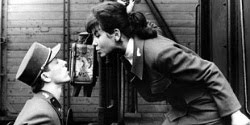 “Closely Watched Trains” (1966)
“Closely Watched Trains” (1966)
Czechoslovakian filmmaker Jiří Menzel’s 1966 coming-of-age debut feature is one of those foreign films we just don’t get. Or rather, it’s one of those highly lauded foreign films — it won the 1967 Academy Award for Best Foreign Language Film, it’s on Criterion, it won a BAFTA, a Golden Globe, etc. — that sort of gives foreign language films a bad name. Or at least, it’s a very poor entry point choice for any semi-intolerable American film student who’s looking to dip their toe into international cinema. Let’s admit it, it’s slow and rather boring. Vaclav Neckar plays a Czech railroad worker during the Nazi occupation, who is so green and pathetic in matters of love he attempts suicide after he has a premature ejaculation with the one woman who will give him a free toss (dude, calm down, no one’s super in control of their junk in their teens). Eventually the naive kid becomes part of the Czech underground and volunteers for a suicide mission for the greater good. He dies. Menzel was asked by the Czech Communist authorities to return his Oscar, but he refused. Or maybe we just need to watch it again. But hell, there’s simply other things to do too, like watch TV. [C]
 “The Narrow Margin” (1952)
“The Narrow Margin” (1952)
One of the things that is undoubtedly attractive about making a film aboard a train is how cheap it can be. Create a few train compartments on your sound stage and you’ve got your film’s locations. While in the hands of most, a film set aboard a train can be economical, in the hands of a few it can be an exercise in suspense. Weighing in at a sleek 71 minutes, Richard Fleischer’s “The Narrow Margin” is such a film. Coming in at the tail end of Fleischer’s noir output, the film is arguably his leanest, meanest, and best. This time around a key Chicago witness, Frankie Neall (Marie Windsor) is ready to testify against a mob boss. Since the trial is in Los Angeles, Mrs. Neall must be transported from Chicago. Despite previous attempts to end her life and shut her up, prosecutors decide a meandering train ride from Chicago to Los Angeles is the best way to transport her. For protection, Mrs. Neall is joined by Detective Walter Brown (Charles McGraw), a tough-as-nails Chicago cop. Needless to say, Mrs. Neall and Brown are joined by a few of the mob boss’ cronies determined to silence her once and for all. What ensues is a methodic cat-and-mouse dance across train cars and compartments as Brown attempts to outmaneuver the gangsters. Fleischer does a wonderful job of using every cramped piece of real estate on his train set to maintain the suspense by keeping the camera static, heightening our sense of confinement. Towards the end of the film, an unexpected reversal (which I won’t ruin here) takes place, completely changing our view of the film. For you cynics out there: yes, planes were in existence. Just overlook this slight leap of logic and enjoy the ride. There’s also a 1990 remake with Gene Hackman and Anne Archer which is decent enough, but doesn’t hold a candle to the original. [A-]
 “The General” (1927)
“The General” (1927)
“Unstoppable” isn’t the first film to take a real train-based incident and use it as the inspiration for a breakneck actioner: 83 years ago, Buster Keaton pulled the same trick, loosely adapting the Great Locomotive Chase, when Union soldiers stole a Confederate train in 1862, into his masterpiece “The General.” The silent star plays an engineer, rejected from signing up with the Confederates because he’s too valuable to the railroad, who’s forced into action when dastardly Union spies steal his beloved titular train, which also happens to have his lady-love on board. While the pro-South politics are a little difficult to relate to, the film, which was panned on its release and became a financial disaster, is a triumph. It’s perhaps not Keaton’s funniest film, but it’s easily his most exciting; the action sequences influencing pretty much every track-based chase that’s followed in its wake. Keaton’s stuntwork is genuinely death-defying, and never less than totally charming, while the collapse of a burning bridge with a train on it near the end is as stunning a money shot as anything you can see with the benefit of CGI. If you’ve never seen it, and we can’t think why you wouldn’t have, the whole film can be seen (with a bombastic temp score, natch) on YouTube here. [A]
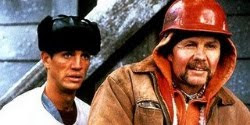 “Runaway Train” (1985)
“Runaway Train” (1985)
Based on a screenplay by Akira Kurosawa, who intended to direct it, “Runaway Train” instead got rewritten by a couple of guys we’ve heard next to nothing from since, and was helmed by Russian theater/film director and writer Andrey Konchalovski, whose next move (and biggest Hollywood film) was “Tango and Cash.” And it would seem that very little that might be recognizably Kurosawa is left. Since its release, though, the film has gained the kind of insider-y, overlooked-cult-classic stamp of critical approval unusual for a genre film, and yes, it does provide some pleasures in its simple linear narrative (the closest thing on this list to “Unstoppable” in terms of plot) and the efficiency of the telling. But don’t be too swayed by the all-out raves — while Jon Voight proves a bright spot, and Rebecca De Mornay does pretty well too, Eric Roberts is far too reliant on shouty overacting to convince here, and overall the film falls short of its higher aspirations. Turns out, the fact that Kurosawa once breathed upon an earlier version of your screenplay does not by some alchemical process turn the end result into gold. But, if you go in expecting nothing more than a pretty daft thriller in which the good slightly outweighs the bad, and you may enjoy it more. [B-]
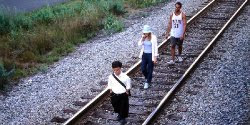 “The Station Agent” (2003)
“The Station Agent” (2003)
On paper, the logline of “The Station Agent” — a train-loving dwarf, an optimistic coffee stall owner, and a grieving mother form a friendship — sounds like a parody of a Sundance indie that might crop up in a lackluster inside-baseball picture like “What Just Happened?” or “State and Main.” But it’s a testament to veteran character actor Thomas McCarthy’s debut feature that it turns out to be as effortlessly charming and moving as it is. The leads are exceptional: Peter Dinklage, displaying for the first time the prickly charm that makes him such a compelling screen presence, Bobby Cannavale, shining in a way he’s rarely had the opportunity to do since, and the reliably great Patricia Clarkson being… well, reliably great. Even the supporting cast are top-notch, including an early appearance from John Slattery, now iconic as Roger Sterling on “Mad Men,” as Clarkson’s estranged husband, and one of the earliest indications that Michelle Williams might turn out to be one of the most gifted actresses of her generation. The theme of unlikely people finding connection has become something of an indie cliché over the years, but rarely does it feel as unforced and genuine as it does in McCarthy’s witty, wonderful film. [A-]
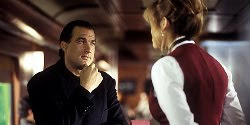 “Under Siege 2: Dark Territory” (1995)
“Under Siege 2: Dark Territory” (1995)
Unremittingly awful from its opening frame until about three minutes from the end when, thanks to a bunch of huge explosions and some severed fingers, things briefly get interesting. “Under Siege 2: Dark Territory” is really only remarkable for featuring one of the finest ensemble casts of C-list villain actors ever assembled: Eric Bogosian probably has the most name recognition of all of them (we are talking C-list), and yet you’ll recognize at least eight of the henchmen’s faces, spend the rest of the film wondering what you saw them in, and occasionally remembering. Which is good because it provides distraction from the tedious drivel on the screen: something to do with a spy satellite, a train full of hostages and blowing up the Eastern seaboard, but all Steven Seagal wants to do is be a chef, mourn his estranged brother and take care of his niece, who, in a stroke of casting genius, is supposed to be likable and yet is played by Katherine Heigl. Those who suggest it’s ‘Die Hard on a train’ have obviously never seen “Die Hard,” or possibly any other film. [D]
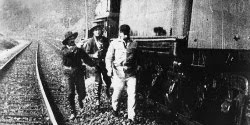 “The Great Train Robbery” (1903)
“The Great Train Robbery” (1903)
Debatably the most famous silent film featuring trains (next to the Lumière‘s “Arrival of a Train at La Ciotat,”) this was one of the most daring for its time, using several on-set locations, cross-cutting (two different locations at the same period of time), and selective coloring. The narrative is simple by today’s standards, with a group of bandits hijacking and looting a train only to be gunned down by the law enforcement at the end. Let us not focus on some of the more dated elements (bombastic silent movie acting) or the homages other directors have done (Scorsese, Spielberg), but the many elements are not only great for its time, but are even accomplished by today’s standards. Unlike many modern filmmakers, director Edwin Porter doesn’t waste a second starting his film, shedding story title cards and beginning with the bandits holding up the station employee. After the excitement leaves the station, every subsequent scene (or shot, there’s only one angle per scene) is skillfully blocked with fantastic frame arrangement, featuring some of the very first camera pans. One scene involving the bandits ordering everyone off the train is still one of the finest composed frames in cinema. As they file out and fill the entire top half of the frame, one makes a break for it and is immediately gunned down. It’s honestly chilling, the entire scene is visually arresting and is a testament to Porter’s artistry, a filmmaker easily forgotten aside from this gem. Other masterful scenes such as the town dance and the final shootout prove to be a lot more interesting than most sequences in modern Hollywood filmmaking (however pretentious that may sound), and it still holds the throne for the most badass last shot of all time. [A]
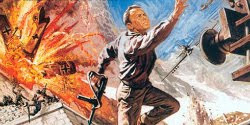 “Von Ryan’s Express” (1965)
“Von Ryan’s Express” (1965)
Part WWII POW escape caper, part culture clash examination, Mark Robson’s 1965 film owes a great debt to the better regarded (and probably just better) “The Great Escape” (1963). Not that “Von Ryan’s Express” is at all bad, actually it’s an entertaining and inventive film, with added interest derived from being set in famously-ambivalent-about-whose-side-it’s-on Italy. However, the personality clash plot line seems a little familiar — dealing with the difference in command style between Frank Sinatra’s ranking American colonel, a pragmatist who will play nice with the camp commandant if it gets the other POWs decent food and clothing, and Trevor Howard as the British major who utterly believes, as do his men, that his first duty is to continue to try to escape no matter what privations result. That they eventually work together and earn each others’ respect should come as no surprise; in fact, to anyone who has seen “The Great Escape” (i.e. everyone) very little in ‘VRE’ comes as a surprise, except possibly the exciting extended train sequence which involves dressing a priest up as a Nazi, silently killing Germans atop moving carriages, and taking track from behind to lay in front, Wallace & Gromit-style. It’s a solid piece of work but in the end, even its affecting conclusion can’t escape the long shadow of its more famous predecessor. [B]
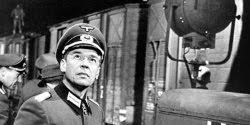 “The Train” (1964)
“The Train” (1964)
Words cannot express our gratitude to Tony Scott for making the film that inspired this list that in turn demanded we finally get around to watching this John Frankenheimer classic — it’s an absolutely terrific film, and we are duly redfaced for not having seen it before. Shot in beautifully textured black and white, the story details a disheveled French train controller with ties to the Resistance (a completely committed, amazingly physical Burt Lancaster), who comes up against a ruthless Nazi (a blistering Paul Scofield) when the latter attempts to move a priceless trove of paintings to Germany in the Third Reich’s dwindling days just before the liberation of France. Touching (never glibly) on an array of fascinating subjects like the value of art vs. the value of life, the nature of obsession, and even the class struggle, the really impressive thing is the film never stops being a breathtaking adventure too (the screenplay by Franklin Coen and Frank Davis was Oscar-nominated). And then there’s the photography which attains a degree of realism rarely seen in WWII films — maybe because they actually did everything for real; stunts were performed by the actors themselves (there’s a thrill to be had in watching Lancaster repair a coupling rod from scratch, or lay explosive, or operate levers and signals like an old hand and see that it’s actually him doing it), train collisions were achieved by colliding actual trains; everything about the railroad was practical and real and it shows. There are other stellar films on this list, to be sure, but make sure to seek this one out if you haven’t already — if you’re anything like us, it’ll make your week. [A+]
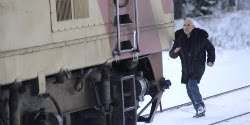 “Transsiberian” (2008)
“Transsiberian” (2008)
Ever since his horror flick “Session 9,” Brad Anderson’s been carving out a niche for himself, in between frequent TV work on the likes of “The Wire” and “Fringe,” making consistently interesting, if flawed, genre pictures. While none have been out and out successes, easily his most satisfying film is the train-set noir “Transsiberian.” Following a Christian missionary couple (Woody Harrelson and Emily Mortimer, the latter particularly good) who become embroiled in a drug smuggling plot led by their cabin-mates (Eduardo Noriega and the terrifically ambiguous Kate Mara), it’s one of the better Hitchcock take-offs in recent years; there’s a complexity to the characters that you don’t find in similar genre pictures, and an exotic color thanks to the chilly Siberian landscapes. Ben Kingsley turns up as a very modern Russian villain as a corrupt cop, and it’s one of his better recent performances too. Unfortunately, like so many thrillers, the film doesn’t stick the landing, with a deus ex machina train crash proving a little too convenient, and its moral ambiguity is ultimately sacrificed. But for the majority of its running time, it’s a neat little noir thriller well worth checking out. [B+]
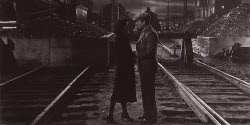 “La Bête Humaine”(1938)
“La Bête Humaine”(1938)
All together now: the greatest director who ever lived was Jean Renoir. Now that we’re all in agreement, let’s soak in this excellent picture featuring one of the most handsome and debonair French actors to ever hit the screen; Renoir mainstay Jean Gabin (total man-crush since the moment we laid eyes on him in “Grand Illusion”). And like many of the films in this feature, “La Bête Humaine” (rough translation, “The Human Beast”), is not really a train film per se, but instead is a film about lust, the folly of man and his innate lack of moral fiber and mental illness. At its epicenter is a tragic, sordid and immoral love triangle. Jean Renoir is a train engineer who lusts after his co-worker’s wife (Fernand Ledoux and Simone Simon, respectively) and from there it gets ugly. She’s having an affair, he forces her to assist in the cuckolder’s murder and poor Jean Gabin, trying to hide his own secret of mental instability from childhood witnesses the entire thing in the railway yard, but is so torn by his ardor for the woman, he keeps his mouth shut. Gabin eventually falls for Simon — a sexual manipulator if their ever was one — and she then convinces him he must kill her husband. The great Fritz Lang remade the film as “Human Desire” in 1953, but even he could not reach the heights, sorry, depths of ugliness the human soul burrows down into this hypnotic, ignoble and yet romantic film. Also, if you’ve ever wondered if films from the 1930s might be too slow, undynamic and far too dated, one must witness everything that Renoir made during that period — and otherwise — to get slapped into the reality of thinking otherwise. [A-]
 “Night Train to Munich” (1940)
“Night Train to Munich” (1940)
Yes, that date is correct — this is a WWII film that came out just a year after that war started and five years before it ended, meaning director Carol Reed did not have the benefit of, you know, knowing who would win or anything. As such, it’s an interesting piece of work, or more properly, of British propaganda, that even features actual newsreel footage of Hitler and the Nazi army as part of its prologue (lots of goosestepping feet marching across maps of the Sudetenland etc.). It’s astonishing how prescient the film feels if not in predicting actual events then at least in establishing the Nazi archetype that would go on to haunt films for generations — a cruel, ruthless, ideologue, blinded to the “British” virtues of decency, humour, and pluck. The Gestapo double agent played by the always awesome Paul Henreid (or Paul von Hernreid as he is here; you’ll remember him from “Casablanca”) is almost a template for future movie Nazis, but one developed before many of the worst excesses of the Third Reich, like the Final Solution, had even been put into action, let alone discovered by the Allies (please watch this and then watch “Top Secret” to see some great Nazis-are-evil spoofing). More a car, boat, train and cable car movie than simply a train film, it does feel rushed and rather giddy at times, with nowhere near the polish of, say, Reed’s “The Third Man,” and yet as an example of how Britain mythologized the war even while it was in progress, it remains a fascinating and valuable document, with added Rex Harrison at his coolest. [B+]
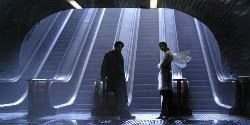 “Kontroll” (2003)
“Kontroll” (2003)
Hollywood may have dulled Nimród Antal’s style, but the feature that got him noticed is still the best work he’s put in — although we have a soft spot when it comes to “Predators.” With 2003’s “Kontroll”, Antal is our guide to the mad world of Budapest’s train system. Bulcsú (Sándor Csányi) is a ticket inspector, a figure reviled by fellow strap hangers and a man who exclusively logs hours below ground. When a serial killer seriously shakes things up by generously aiding people onto tracks and under train wheels, Bulcsú must survive brief encounters with the killer, a nameless love interest (Eszter Balla) and rival teams of inspectors who parlay him into a very dangerous hobby. With touches of Wong Kar-Wai-like dreamy wonder but infused with a steroidal pacing, “Kontroll” is hypnotic and alluring. Csányi and his sad sack eyes make for a wonderfully relatable lead and a pulsating score by electronica artist Neo keeps the film’s darker themes a touch away — this is a lighthearted romp through grim territory and all the better for it. [B+]
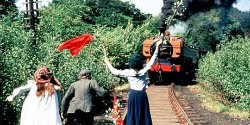 “The Railway Children” (1970)
“The Railway Children” (1970)
Full confession: there are some films that a particular reviewer may be ill-qualified to objectively dissect and this is one such case. The 1970 Lionel Jeffries version of the E. Nesbit novel is as much a childhood Christmas memory round these parts as “The Sound of Music” or gross overeating. So it’s very difficult to know if, coming to it fresh, an unbiased writer might find its Victorian values and perky do-gooder children insufferably cloying or whether they’d be happily entranced with the plucky Britishness on display and moved to tears (no seriously — every bloody time) by the “Daddy, oh my Daddy” bit at the end. Suffice to say, this writer loves it, and never ceases to be vaguely shocked by Jenny Agutter’s edgier (and way nuder) roles since. It’s gentle and goodhearted and filled with paper chases, kindly gentlemen, flannel petticoats and waving at trains; a charming, sweet portrait of a bygone age that in actuality doubtless didn’t resemble this one bit. [A]
Honorable Mentions: Forgive us our omissions — for the sake of clarity, we steered away from subway train movies (and also because we’re sick to death of writing about either of the ‘Pelham 1 2 3’s), so various horrors like “Mimic” (1997) and “Midnight Meat Train” (2008) didn’t make the cut. We also are aware that there are many films, good and bad, that feature striking train sequences like “Some Like It Hot” (1959), “Bridge on the River Kwai”(1957), “Wanted”(2008), “Mission: Impossible”(1996), “Before Sunrise”(1995), “The 39 Steps” (1935), and “North by Northwest”(1959). But unless the film was primarily set on, in, or around trains, we excluded it. Even with those exclusions, there are some films we just didn’t get to that in all honesty should probably have been featured. These honourable mentions go to Sidney Lumet’s “Murder on The Orient Express” (1974) (good, campy fun featuring an everyone-who’s-anyone cast who all seem to have a tremendous time), Robert Zemeckis’ ugly CG/mo-cap pioneer “The Polar Express” (2004), the Wesley Snipes/Woody Harrelson vehicle “Money Train” (1995) (about which the most comprehensive review we could coax from any of our writers was “a pile of roasted shit”), “Twentieth Century” (1934), a Howard Hawks classic featuring probably John Barrymore’s best performance, the Von Sternberg/Dietrich collaboration “Shanghai Express” (1932), India-set epic “North West Frontier” (1959) with Lauren Bacall and Kenneth More, and Cary Fukunaga‘s riveting debut feature set entirely on top of a train, “Sin Nombre.” And from the train comedy subgenre, both the Wilder/Pryor vehicle “Silver Streak” (1976) and the pretty obnoxious “Strangers on a Train” retread, “Throw Momma From the Train” (1987), got overlooked due to us not being arsed. There are many, many, more of course, but we’re slowing down, gathering our bags and pulling in to the station now, so if we’ve missed your favorite, feel free to sound off in the comments.
— Jessica Kiang, with Tan Nguyen, Rodrigo Perez, Christopher Bell, Katie Walsh, Mark Zhuravsky, Oli Lyttelton,
